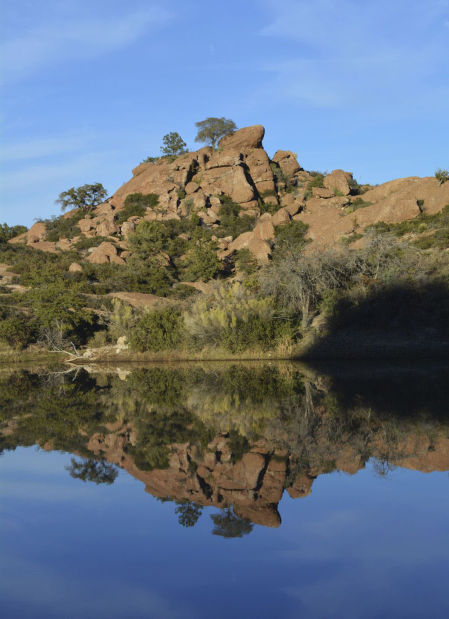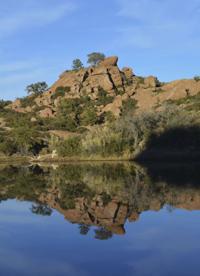The Oak Flat campground area that will be destroyed by a proposed copper mine has been added to the National Register of Historic Places, based in part on the siteтs spiritual ties to Western Apache tribes.
But the listing of the site, about 100 miles north of УлшжжБВЅ, has prompted outrage from Rep. Paul Gosar, R-Ariz., who insists it has no special significance to Native Americans.
Gosar backed legislation to privatize Oak Flat and surrounding lands, paving the way for the mine. He recently the тbogusт designation from the National Park Service. The NPS deemed the тChiтchil Bildagoteelт district, which includes Oak Flat, to be a тtraditional cultural property,т following a nomination from the U.S. Forest Service in consultation with the San Carlos Apache tribe.
People are also reading…
Reps. Gosar and Ann Kirkpatrick, D-Ariz., repeatedly asked the National Park Service to withdraw the nomination.
тRep. Gosar believes this deceptive behavior points to collaboration between environmental groups, hell-bent on sabotaging a mining project, and the Park Service,т Steven Smith, Gosarтs communications director, said in an email last week.
But a tribal historian with the Yavapai-Apache Nation т one of the many УлшжжБВЅ tribes opposed to mining at Oak Flat т said lawmakers are both overreacting to the listing and are тignorantт of the areaтs significance.
The historic designation wonтt stop efforts to mine the rich copper deposit beneath Oak Flat, said Apache Elder Vincent Randall, 75. The Yavapai-Apache Nation, comprising two distinct people, is in the Verde Valley, near Sedona.
тIt doesnтt have any teeth,т Randall said. тItтs a victory maybe in that more people will understand this is a special place.
тBut as far as the designation, itтs not stopping the mine.т
The listing means that during the pre-mining environmental-review process, stakeholders will have to thoroughly evaluate the impact on the historic site, which could add delays to the mineтs timeline, said David Johnson, heritage manager for the U.S. Forest Serviceтs Southwestern region.
тThey have to consider and disclose the effects, but it doesnтt stop it,т he said.
The designation is important from a public-relations standpoint, said Curt Shannon, УлшжжБВЅ policy analyst for the Access Fund, a land-preservation group. Mine supporters have repeatedly denied the importance of Oak Flat, and thatтs harder to do now, he said.
тThere will be a lot more public opinion opposed to this, as a result of the designation,т he said.
Resolution Copper Mining LLC respects both viewpoints regarding whether the site is sacred, spokesman Bill Tanner said in an email. Resolution is jointly owned by U.K.-based Rio Tinto Group and Australia-based BHP Billiton Ltd.
But he said the mineтs economic benefits are also worth consideration.
тWe have also heard from many Native American employees and contractors that work with Resolution Copper, who have told us of the desperate need for economic development and jobs in the Copper Triangle,т he said.
SACRED SITE
Legislators who say the site isnтt sacred are ill-informed, Randall said. Oak Flat is considered one of the sources of Gaтan, or Mountain Spirits, for the Apache people. Itтs also the place of origin for the Apache group known as Dilzheтe, from which a number of todayтs Apache clans are descended, Randall said.
Gosar and Kirkpatrick objected to the redaction of specific location details in Oak Flatтs nomination for the National Register, saying it made it harder for citizens to find and object to the nomination.
But Randall said the specific locations of holy places are a closely guarded secret т even among Native Americans. On the Yavapai-Apache reservation, Apache elders ask that members only speak of those sites in their own language, so tribal members without close ties to their heritage donтt know exactly where they are, he said.
Elders fear if word got out, tourists, souvenir seekers or тcrystal people and vortex peopleт would flock to sacred sites and inadvertently destroy them, Randall said.
тOur elders have said if we share some of these most holy places, it gets desecrated,т he said. тThat puts us out of harmony with our creator.т
Tribes in УлшжжБВЅ and New Mexico have submitted letters to Congress and the Obama administration objecting to legislation that turned over 2,400 acres of the Tonto National Forest т including Oak Flat т to Resolution Copper, in exchange for 5,300 acres Resolution owns.
Those writing in protest of the land swap, first proposed in Congress in 2005, included the Yavapai-Apache Nation, the Fort McDowell Yavapai tribe, the San Carlos Apache, White Mountain Apache and Jicarilla Apache, and УлшжжБВЅтs closest tribes, the Tohono Oтodham Nation and Pascua Yaqui. The Inter-Tribal Council of УлшжжБВЅ sent letters of opposition, representing its 20 member tribes.
тSir, I can not begin to express what this land means to the Yavapai People. It simply transcends words,т Clinton Pattea, then-president of the Fort McDowell Yavapai tribe, wrote in a letter to President Obama, objecting to a 2009 version of the land swap.
After nearly a decade of failing to pass the land swap on its own, lawmakers, including Sen. John McCain, R-Ariz., quietly added the provision into a must-pass, military spending bill at the end of 2014 т a move by mine opponents and Native American tribes.
SAN CARLOS APACHE
Resolution Copperтs proposed mining method т block-cave mining т will extract a huge amount of rock from underneath Oak Flat, eventually resulting in a 2-mile-wide crater as the surface collapses into the underground void, Resolution says.
Members of the San Carlos Apache tribe are camped out at Oak Flat in protest of the mine. San Carlos Apache leaders say the tribeтs spiritual beings live within the Oak Flat, Gaтan Canyon and the Queen Creek area. The Apache collect medicinal plants and acorns there, and conduct ceremonies including the Sunrise Ceremony, honoring girls entering womanhood.
Gosarтs office points to published last year by a former historian for the San Carlos Apache tribe arguing Oak Flat was not considered sacred until recent years.
тThere has not been a long history of ceremonial or cultural activities such as Sunrise or Holy Ground ceremonies taking place at Oak Flat,т Dale Miles, former tribal historian for the San Carlos Apache, wrote for The УлшжжБВЅ Republic.
The Apache are not a monolithic group, especially in San Carlos, where Apache from various clans were brought forcibly in the 19th century, said Scott Wood, who retired last year as the Tonto National Forestтs archaeologist and heritage program manager. He spent 40 years at the Tonto National Forest, often working at Oak Flat.
тItтs true you could find an Apache from San Carlos who says, тOak Flat has no meaning to my family,тт Wood said, тbut as long as it has significance to some portion of that group, and that significance is recognized by the tribal government and by their appropriate religious practitioners, then itтs there.т
ARCHaEOLOGICAL RECORD
But Oak Flatтs religious significance isnтt the only reason why it qualifies as a traditional cultural site, Wood said.
тItтs got enough in the way of regular archaeological resources out there, particularly Apache archaeological resources, that itтs eligible for National Register, anyway,т he said.
Forest Service and other archaeological surveys have uncovered evidence of Apache occupations from the 19th century, such as early villages, small agricultural settlements, rock shelters and roasting pits for processing agave, as well as relics from prehistoric occupation by the Hohokam people.
тIt was very clear in the evidence it was eligible for the National Register,т Johnson said.













